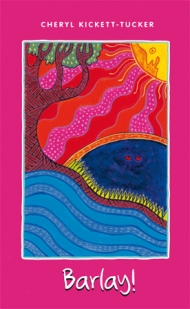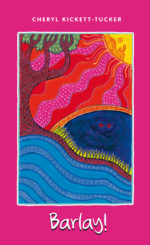INTERVIEW: Cheryl Kickett-Tucker

Cheryl Kickett-Tucker’s slightly spooky children’s book Barlay! has an important message for young kids.
When did you first hear the story of the woordatj?
I heard it from my mum when I was seven or eight. We were holidaying down in Katanning, and we went over a small hill where the woordatj lived. She’d tell us about the woordatj to make sure we went back to the car before it got dark.
How important was the bush in your experience when you were growing up?
It was extremely important, it meant getting out in the open, breathing fresh air. It provided an opportunity to be in nature, learn about nature and hear stories about the old people. The bush is really important to learning about our culture. And being out in the bush meant getting family together, whether it was around a campfire or at home.
What part do you see family relationships playing in kids’ learning?
Family relationships are so important to how kids learn. Parents are role models for their kids, in the way we act or the way we don’t act. And body language plays a big part in that – Aboriginal people communicate really well with body language. Body language is especially important when you’re telling stories.
Most readers will read your book on their own – how different is that to if you were reading it to them?
When I read from Barlay! to a group of kids it’s like I can put it in first-person for them, whereas if they’re reading it on their own it’s a third-person experience for them. I use body language a lot when I’m reading to people – you’ve got to be animated with kids, engage them not bore them. They enjoy the story more when I move around and speak loudly and softly.
How did you get involved in the Waarda series?
Jill Milroy (Dean of Indigenous Studies at UWA) came to me three years ago and told me about a children’s book series they were planning, and asked me if I was interested. I said I’d love to – I’ve always wanted to write a children’s book! It was another two years before it came to fruition, and around that time Sally Morgan approached me to take part in a workshop for another book (this was a book for women). And in that workshop Sally just won me over with her expertise and professionalism. Later she invited me to another workshop about children’s books, and she gave me a few kids’ books to read. After that I just put pen to paper and got writing.
Did you find the process of writing Barlay! easy?
No, it was really hard actually. I’m a researcher, I have a doctorate and I work at Murdoch University, so I come from a background of Western scientific report writing. I had to change my whole way of thinking to write a creative children’s book. So it was hard work – but Sally was really encouraging. She’d say, don’t worry it’s normal to feel like this, and tell me it was going well. So she was a great help.
You use quite a few Nyungar words (with English equivalents) in the book. Why did you choose to do this?
I wanted to teach both Aboriginal and non-Aboriginal kids the Nyungar language. I do a lot of research that involves me working with kids, and lots of the Nyungar kids I talk to don’t even know their own language. I included Nyungar words in my story so that kids of all backgrounds would be introduced to the language, and to help Nyungar kids see they don’t have to be embarrassed about their own language. It’s a start towards them learning it, even if it’s just a few words.
What do you hope readers of Barlay! will learn from reading it?
These kinds of stories always have a moral – in mine it’s about being respectful of your elders and learning from them. There’s a smaller moral of being careful in the bush too, as I write about leaving a trail when you go walking in the bush. And I really hope kids will enjoy the book, that they’ll have fun reading it and enjoy the illustrations and the bright painting on the cover!



